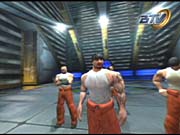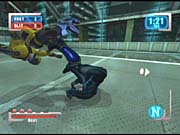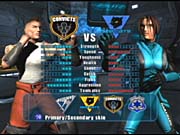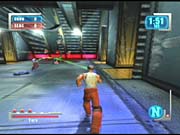Let's get the obligatory reference to the 1975 film Rollerball out of the way right off the bat in describing Ubi Soft and Swedish developer SouthEnd Interactive's Deathrow. Clearly inspired by that film's grim vision of a violent, futuristic, no-holds-barred spectator sport, Deathrow is one part sports game, one part fighting game, and one part first-person shooter. Deathrow also features some impressive visuals, excellent audio (albeit filled with more foul language than you've probably ever heard in a game), and intense, action-packed gameplay with a good amount of depth. Deathrow's graphic violence and excessive swearing mean it's not exactly the game to get your kid brother, but most Xbox owners should find in it a highly gratifying experience that's equally well suited for single-player or multiplayer mayhem.

Deathrow has no relation to Suge Knight's mid-'90s rap music label of (nearly) the same name, and you may be surprised to know that the game's title isn't actually the name of the futuristic sport that the game features, either. Instead, the sport is called blitz, and it's sort of a full-contact cross between hockey and basketball, in which two teams of four players try to outscore each other by throwing an energized disc through the small loop that is the opposing team's goal. To relieve the opposing team of the disc, players are encouraged to act as aggressively as possible, using punches, kicks, tackles, throws, and more. The game's title refers to a technique whereby players charge up the disc and then use it as a powerful projectile attack that is useful for knocking out enemy goaltenders. By default, blitz matches consist of four two-minute quarters, and the resulting game is as brutal as it is intense. Though goals in blitz are worth a point each, with a good offense, it's possible to keep the disc in play on the opposing team's side and rack up many points quickly.
According to the game, blitz started as an illegal underground sport in the late 22nd century, but some decades later, it's become one of the most widely watched entertainment events around. Now the toughest, meanest blitz teams from all around the galaxy are convening to participate in the Blitz Disc Association's biggest tournament yet. Initially, you can play as one of four of these teams, though more than 10 can be unlocked as you progress. Each team is ranked differently in categories like strength, speed, toughness, aggression, and passing and shooting. Furthermore, each individual player is unique, with his or her own stats and appearance, and there are well over 100 different players in all. Aside from their different looks and colorful expressions, however, the various teams aren't so different. Most basically play exactly the same in action, and they don't have unique special moves or other such techniques to set them apart. Powerful teams will want to rely on pummeling their foes, while fast teams will want to rush the goal, but other than that, the same core strategies apply to all blitz competitors.
For a game that seems completely lacking in subtlety, Deathrow actually has a fair amount of depth. Each of the different teams in the game has its own home arena, and these attractive venues have an significant impact on the sort of match that's going to take place. This isn't obvious at first--most Deathrow arenas initially look like big rectangles with goalposts at opposing ends. You might expect that various hazards or environmental obstacles would be present to get in your way as you compete, but there's nothing of the sort. Nevertheless, the variations in size and layout of each arena do make a big difference in practice. Sometimes the goal area is tucked away in a little nook that lets the opposing team easily retrieve the disc and keep scoring. In an interesting touch, you can often score by throwing the disc either through the front or the back of the goal ring. Sometimes there's a significant distance between the opposing goals, giving fast teams the advantage. Sometimes floor fans enable players to jump very high in the air in some spots. Learning the ins and outs of each of the game's arenas proves to be quite rewarding.

The gameplay itself, while accessible, has a bit of a learning curve. The adjustable control scheme defaults to a setup similar to what you'd find in a first-person shooter. You can run, pass, and shoot. You can punch, kick, and throw. You can jump, slide tackle, or dive tackle. You can taunt, throw fake passes, and use evasive rolls. You can even pound on an opponent whom you've already knocked down, savagely punching and stomping the poor fool. Almost all these techniques are useful, and knowing when and how to use each of them to their fullest potential will take practice. One issue with the gameplay is that the slide tackle also gives the player a burst of speed, so you might as well use it more often than not. But you'll still need a variety of techniques to succeed. The controls are highly responsive, and the collision detection is convincing and consistent. The game also does a good job of keeping you oriented toward the disc at all times, and a color-coded indicator constantly informs you of which team is in possession.
Deathrow's main mode of play is called conquest, and it's basically similar to a season mode in a sports game, though it's structured more like a fighting game--you challenge tougher and tougher teams one after another until you reach the finals. In between matches, you'll be able to train your team members, hire new ones, or compete in some optional matches, but in reality, the conquest mode is very straightforward. But that's not that big of a problem, since the arena is where you'll want to be spending your time anyway.
During matches, you'll find that the opposing team presents a significant challenge and that the members of your team do a good job of helping you out. Luckily, you'll get to do most of the work yourself--your mates will usually pass you the disc instead of taking a shot themselves, and if you pass the disc to one of them, you'll instantly switch control to the receiver. Meanwhile, the rest of the team will do its best to keep your foes off your back and defend the goal. Also, using the D pad, you can cycle through a number of team strategies, ranging from all-out defensive to all-out offensive. These options can help make a difference in a close match, but switching between them isn't essential to success, since your teammates are smart enough to go where the action is no matter what.

Meanwhile, opposing players act noticeably differently depending on their aggression ratings, and they may be quick to fight or may concentrate on trying to score. Deathrow matches are often pitched, but you won't get the sense that the closeness of the scores is orchestrated--you'll just feel like you're taking on some very tough competitors. Inevitably, you'll be on the edge of your seat for the entirety of each match, since letting down your guard for a moment or two may easily cost you a victory.
The game offers two different perspectives of the action, an "action view" and a "sports view." The former is a behind-the-back, third-person perspective that is reminiscent of what you'd find in many 3D action games these days. The latter is more of a top-down, isometric perspective that's farther removed from the action. The action view is therefore a lot more fun. However, the main disadvantage of it is the fact that there's no good way to tell if an opposing team member is coming up behind you--not until he or she crushes you into the pavement, anyway. Strangely enough, you select a view option when you begin the conquest mode and then can't change your setting unless you restart.
Additionally, Deathrow has a number of tweakable parameters that can be used to adjust the length and style of each match. Notably, one option is to penalize players who attack opponents who have already been knocked down. The game also includes a large number of unlockable extras that must be "purchased" using points that are earned by winning matches against the computer. Most of these are teams, players, and arenas, though there are also some gameplay options and concept art waiting to be unlocked.
If you'd rather play with friends than with the computer, you'll be pleased to know that Deathrow allows for cooperative play for up to four players in a split-screen view, though competitive multiplayer options are available as well. It's even possible to link up multiple consoles with multiple copies of Deathrow for network play. Regrettably, though, no Xbox Live support is included. This could have been a really great game to play online.
Deathrow sports some great visuals, the likes of which you couldn't find on any console other than the Xbox. Effective use of the system's proprietary visual effects gives all the arenas a highly believable look, with various surfaces--from steel to wood to glass--that all seem to have real texture to them. Liberal use of motion blur and other flashy effects can make the presentation seem rather gaudy at times, but it's still pretty slick. The game's character models look good but are animated even better, and they boast a variety of brutal-looking motion-captured moves that will make you wince whenever you see them. While the whole "violent futuristic sport" theme isn't terribly original, and while Deathrow's many different teams run the predictable gamut from convicts to aliens to robots to military types, the game's look and style are maintained consistently to excellent effect.

Deathrow sounds even better than it looks. It features a roaring crowd that responds to the ebb and flow of the action of every match and a number bone-crushing effects to accompany the high-powered punches and kicks. So if you've got a 5.1 surround-sound system, this is a fine way to put it to good use. A fittingly enthusiastic announcer merely informs you of the beginning and end of each round, though there's plenty of colorful commentary by the players themselves. Each team sounds completely different, but most teams--for better or worse--are incredibly crass. There are more obscenities in your average Deathrow match than in an episode of Jerry Springer, but they aren't bleeped out in the game. It's actually a bit unfortunate that no option exists to turn the cussing off, since it's bound to offend some prospective players who, for whatever reason, are more averse to swearing than to graphic violence. Even still, the quality of the voice work in Deathrow is undeniably impressive. Despite the large number of different teams in the game, matches begin with slanderous exchanges that are specific to the two teams competing against each other. And, for what it's worth, all the foul language does seem appropriate in the context of the game. A pulsing, energetic techno soundtrack complements the action effectively all the while, but if you want to rip your own music to replace it, you can.
Knowing that the game is chock-full of four-letter words, you might expect that Deathrow is trying to get by on its edgy material. But make no mistake--this is a great game because it's so very intense to play, and the violent animations and unbridled dialogue just add to the effect. Deathrow offers significant challenge and great lasting value even for those not looking to play it with others, since the AI is challenging by default, and even tougher difficulty settings are available. And if you do plan on playing Deathrow with others, you can spend your time concentrating on learning the intricacies of the game and leave the smack talking to your team members.